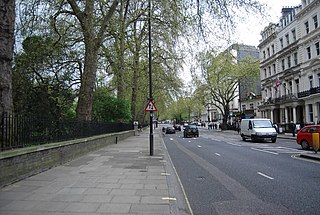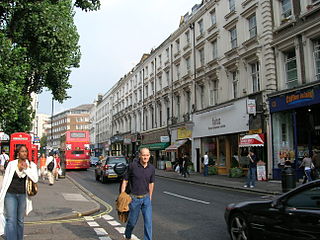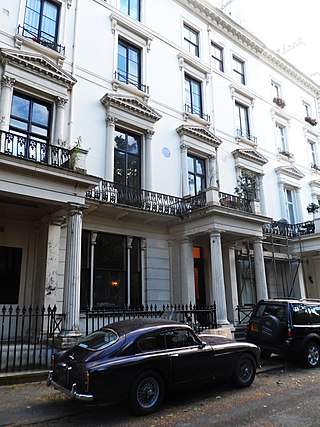Related Research Articles

Westminster is an area of the City of Westminster in London. It extends from the River Thames to Oxford Street, and has many famous landmarks, including the Palace of Westminster, Buckingham Palace, Westminster Abbey, Westminster Cathedral, Trafalgar Square and much of the West End cultural centre including the entertainment precinct of West End Theatre.
The Clapham Sect, or Clapham Saints, were a group of social reformers associated with Clapham in the period from the 1780s to the 1840s. Despite the label "sect", most members remained in the established Church of England, which was highly interwoven with offices of state. However, its successors were in many cases outside of the established Anglican Church.

Bayswater is an area within the City of Westminster in West London. It is a built-up district with a population density of 17,500 per square kilometre, and is located between Kensington Gardens to the south, Paddington to the north-east, and Notting Hill to the west.

Notting Hill is a district of West London, England, in the Royal Borough of Kensington and Chelsea. Notting Hill is known for being a cosmopolitan and multicultural neighbourhood, hosting the annual Notting Hill Carnival and Portobello Road Market. From around 1870, Notting Hill had an association with artists.

Paddington is an area in the City of Westminster, in central London, England. A medieval parish then a metropolitan borough, it was integrated with Westminster and Greater London in 1965. Paddington station, designed by the engineer Isambard Kingdom Brunel opened in 1847. It is also the site of St Mary's Hospital and the former Paddington Green Police Station.

Lambeth is a London borough in South London, England, which forms part of Inner London. Its name was recorded in 1062 as Lambehitha and in 1255 as Lambeth. The geographical centre of London is at Frazier Street near Lambeth North tube station, though nearby Charing Cross on the other side of the Thames in the City of Westminster is traditionally considered the centre of London.

Kensington Gardens, once the private gardens of Kensington Palace, are among the Royal Parks of London. The gardens are shared by the City of Westminster and the Royal Borough of Kensington and Chelsea and sit immediately to the west of Hyde Park, in western central London. The gardens cover an area of 107 hectares. The open spaces of Kensington Gardens, Hyde Park, Green Park, and St. James's Park together form an almost continuous "green lung" in the heart of London. Kensington Gardens are Grade I listed on the Register of Historic Parks and Gardens.

Lambeth was a civil parish and metropolitan borough in south London, England. It was an ancient parish in the county of Surrey. The parish was included in the area of responsibility of the Metropolitan Board of Works in 1855 and became part of the County of London in 1889. The parish of Lambeth became a metropolitan borough in 1900, following the London Government Act 1899, with the parish vestry replaced by a borough council.

The Westbourne or Kilburn is a culverted small River Thames tributary in London, rising in Hampstead and Brondesbury Park and which as a drain unites and flows southward through Kilburn and Bayswater to skirt underneath the east of Hyde Park's Serpentine lake then through central Chelsea under Sloane Square. It passes centrally under the south side of Royal Hospital Chelsea's Ranelagh Gardens before discharging into Inner London's old-fashioned, but grandiose combined sewer system, with exceptional discharges into the Inner London Tideway. Since the latter 19th century, the population of its catchment has risen further but to reduce the toll it places on the Beckton Sewage Treatment Works and related bills its narrow basin has been assisted by private soakaways, and public surface water drains. Its depression has been replaced with and adopted as a reliable route for a gravity combined sewer. The formation of the Serpentine relied on the water, a lake with a long, ornate footbridge and various activities associated, which today uses little-polluted water from a great depth.
William Wilkins was an English architect, classical scholar and archaeologist. He designed the National Gallery and University College London, and buildings for several Cambridge colleges.


The Diocese of Southwark is one of the 42 dioceses of the Church of England, part of the worldwide Anglican Communion. The diocese forms part of the Province of Canterbury in England. It was created on 1 May 1905 from part of the ancient Diocese of Rochester that was served by a suffragan bishop of Southwark (1891–1905). Before 1877 most of the area was part of the Diocese of Winchester, some being part of the Diocese of London.

Regent's Park and Kensington North was a constituency in Central and West London represented in the House of Commons of the Parliament of the United Kingdom. It elected one Member of Parliament (MP) by the first past the post system of election.

The region of Greater London, including the City of London, is divided into 73 parliamentary constituencies which are sub-classified as borough constituencies, affecting the type of electoral officer and level of expenses permitted.

Lieutenant-Colonel James Burton was the most successful property developer of Regency and of Georgian London, in which he built over 3000 properties in 250 acres. The Oxford Dictionary of National Biography contends that Burton was 'the most successful developer in late Georgian London, responsible for some of its most characteristic architecture'.

Westbourne Terrace is a street in the Paddington district of the City of Westminster in west London. The street runs between Westbourne Bridge in the north and the junction of Westbourne Crescent and Sussex Gardens in the south and was developed between 1839 and the late 1850s. It has been described as the "most spacious and dignified avenue" in Bayswater and "unrivalled in its class in London or even Great Britain". The street is not to be confused with Westbourne Terrace Road which runs north from Westbourne Bridge into Little Venice, and a large number of other Westbourne streets in the area.
Robert Palmer Browne was a British architect who was closely associated with the General Steam Navigation Company in the mid-nineteenth century but who also designed residential, church and public buildings, some of which are now listed by Historic England.
William Kingdom was a property developer who was active in the development of tracts of west London in the mid-nineteenth century. These included the Westbourne area where he worked with Thomas Marsh Nelson on Westbourne Terrace, areas north of Craven Road, and most of Gloucester Terrace between 1843 and 1852. He may also have developed Hyde Park Gardens, Paddington.

Sir William Bolland (1772–1840), lawyer and bibliophile, the eldest son of James Bolland, of Southwark, was educated at Reading School under Richard Valpy, and admitted a pensioner at Trinity College, Cambridge on 26 September 1789, at the age of seventeen. During his school days he wrote several prologues and epilogues for the annual dramatic performances in which the scholars took part, and for which Valpy's pupils were famous. At Cambridge he took his degree of BA in 1794, and MA in 1797. For three successive years he won the Seatonian Prize by his poems on the respective subjects of miracles, the Epiphany, and St. Paul at Athens, which were printed separately, and also included in the "Seatonian Prize Poems" (1808), ii. 2133-97. On leaving Cambridge he determined upon adopting law as his profession, and was called to the bar at the Middle Temple on 24 April 1801. Bolland practised at the Old Bailey with great success; he was thoroughly conversant with commercial law, and soon became one of the four city pleaders. From April 1817 until he was raised to the bench he was recorder of Reading. He was a candidate for the common serjeantcy of the city of London in 1822, but in those days of heated political excitement was defeated by the Lord Denman. In November 1829 he was created a Baron of the Exchequer, and held that appointment until January 1839, when he resigned on account of failing health. On 14 May 1840 he died at Hyde Park Terrace, London. Lady Bolland, whom he married on 1 August 1810, was his cousin Elizabeth, the third daughter of John Bolland, of Clapham. An anonymous satire, "The Campaign, to his Royal Highness the Duke of York, Britannia in the year 1800 to C. J. Fox." was written by Bolland in 1800, but not issued for sale, the author confining its publicity to his friends. Although he published but little, he was known for many years as an enthusiastic student of early English literature. Dibdin dwells with unction on the pleasures of the dinner-parties of Hortensius—the fancy name by which he designated Sir William Bolland—and extols the merits of his library. It was at a dinner-party in Bolland’s house on the Adelphi Terrace that the Roxburghe Club was originated, and its first publication was his gift. This was "Certain Bokes of Virgiles Aenæis turned into English meter. By the right honorable lorde, Henry, earle of Surrey." The books were the second and fourth, and the reprint, bearing the date of 1814, though the dedication was signed 17 June 1815, was taken from a copy of the original edition of 1557, which is preserved at Dulwich College. His collections were sold in the autumn after his death, his library of about three thousand articles producing about £3,000. The bust of Sir William Bolland has been a familiar object to all who have studied in the library of Trinity College, Cambridge. A portrait by James Lonsdale is in the National Portrait Gallery.

Arthur Billing (1824–1896), was a British architect.
References
- 1 2 Historic England. "34B York Way (1389313)". National Heritage List for England . Retrieved 15 August 2018.
- 1 2 Pevsner, Nikolaus & Bridget Cherry. (2002). The Buildings of England: London 3: North West. New Haven & London: Yale University Press. pp. 684–686. ISBN 0300096526.
- ↑ Smith, Simon David (2006). Slavery, Family, and Gentry Capitalism in the British Atlantic: The World of the Lascelles, 1648–1834. Cambridge: Cambridge University Press. p. 239. ISBN 978-1-139-45885-6.
- ↑ Thomas Marsh Nelson England and Wales Marriage Registration Index, 1837-2005. Family Search. Retrieved 15 August 2018. (subscription required)
- ↑ Shaftesbury Avenue. British History Online. Retrieved 16 August 2018.
- ↑ "Bankrupts" in The Law Journal. 1841. p. 22.
- ↑ Brodie, Antonia; et al. (2001). Directory of British Architects, 1834-1914: Vol. 2 (L-Z). London: Continuum. p. 247. ISBN 978-0-8264-5514-7.
- ↑ "Bankrupts", The Edinburgh Gazette, 24 June 1881, p. 519.
- ↑ Magnificent archways were part of a much grander plan. Great Yarmouth Borough Council. Retrieved 16 August 2018.
- ↑ Palmer, Charles John. (1875). The Perlustration of Great Yarmouth: With Charleston and Southtown &c. Vol. III. Great Yarmouth: George Nall. p. 148.
- ↑ "Clapham: St John the Evangelist - The Diocese of Southwark". southwark.anglican.org. Retrieved 2020-04-12.